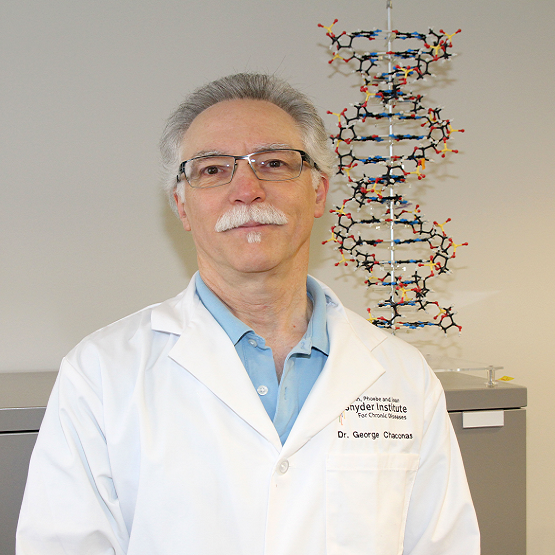George Chaconas
Full Member

George Chaconas
Title
Professor, Department of Biochemistry & Molecular Biology and Microbiology, Immunology & Infectious Diseases
Contact Information:
Biochemistry & Molecular Biology
Microgiology, Immunology & Infectious Diseases (MIID)
Address: 2C62 Health Research Innovation Centre
Phone: (403) 210-9692
Fax: (403) 270-2772
Email: chaconas@ucalgary.ca
Curriculum Vitae:
PhD University of Calgary, 1978
Post-doctoral Studies Cold Spring Harbour Laboratory, 1978-1981
Faculty Member University of Western Ontario, 1981-2002
Sabbatical NIH Rocky Mountain Laboratories, 1999-2000
Potential Graduate Supervisor
Research
Lyme borreliosis (Lyme disease) is the most common vector transmitted disease in the northern hemisphere. It is caused by the spirochete Borrelia burgdorferi and other Borrelia species. The disease is typically transmitted from infected mice to humans by a bite from an infected tick. If not properly diagnosed and treated, Lyme disease can be severely debilitating and may result in arthritis, neurological symptoms, heart abnormalities and a variety of other problems. Global warming is promoting the expansion of areas where infected ticks and Lyme borreliosis is found.
Borrelia burgdorferi is a fascinating organism with a variety of intriguing features. Our studies focus on several aspects of the biology of Borrelia burgdorferi:
1) Antigenic variation – By constantly changing the sequence of a surface-bound liopoprotein, VlsE, B. burgdorferi can stay one step of the host immune system and outrun the acquired immune response. This escape in immune-surveillance results in persistent infection of the host. The antigenic variation process is driven by gene conversion events at the vlsE locus, molecular details governing antigenic variation remain unknown and are under investigation in the lab.
2) Global gene regulation by the HrpA helicase – Global gene regulation is an important feature in the B. burgdorferi life cycle. The expression of about 150 genes is regulated as the spirochete transitions from the tick vector to the vertebrate host. We have shown that one of the global regulatory pathways involves the HrpA RNA helicase. Infection cannot occur in the absence of HrpA. Moreover, while many bacteria have multiple RNA helicases, B. burgdorferi encodes only the HrpA RNA helicase, making Borrelia a good model system for functional studies on HrpA.
3) B. burgdorferi dissemination – Lyme spirochetes can enter the host vasculature and ride for free throughout the body, exiting at diverse locations to cause a variety of problems. The process of dissemination is complex and poorly understood. In collaboration with the labs of Jenifer Coburn (Medical College of Wisconsin) and John Leong (Tufts University) we are studying this important problem. Our intravital microscopic analysis has revealed important new information and is the first high resolution imaging of spirochetes at work in a living mammalian host (see video links).
We use a wide variety of methodologies to study the above problems, including genomics, proteomics, molecular biology, genetics, next generation sequencing, nucleic acid biochemistry, protein biochemistry, structural biology and intravital microscopy.
People

Genevieve Chaconas
Genevieve Chaconas
Email: gchacona@ucalgary.ca
Mildred Castellenos
Mildred Castellanos
Email: mcescami@ucalgary.ca

Colton Scott
Colton Scott
Email: Colton.scott@ucalgary.ca

Daiana Alvarez Olmedo
Daiana Alvarez Olmedo
Email: daiana.alvarezolmedo@ucalgary.ca

Sasha Shcherbakova
Sasha Shcherbakova
Email: aleksandra.shcherbak@ucalgary.ca

BCID 2025 Lab Photo
BCID 2025 Lab Photo
